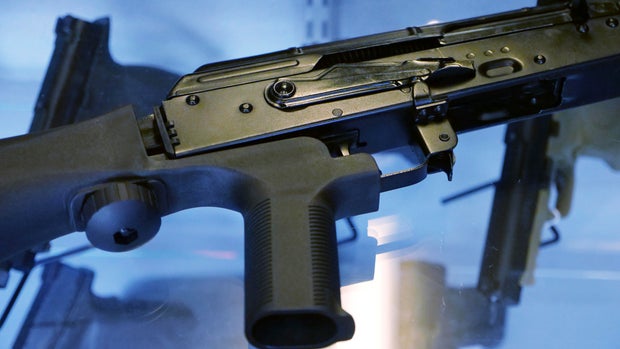Washington — The Supreme Court on Friday invalidated a federal rule enacted during the Trump administration that outlawed bump stocks, devices that greatly increase the rate of fire of semi-automatic weapons.
The 6-3 ruling found that the Bureau of Alcohol, Tobacco, Firearms and Explosives exceeded its authority when it issued the ban in 2018, following the 2017 mass shooting at a music festival in Las Vegas, the deadliest in U.S. history. Justice Clarence Thomas delivered the opinion of the court, which split along ideological lines. Justice Sonia Sotomayor read her dissenting opinion from the bench.
“This case asks whether a bump stock — an accessory for a semiautomatic rifle that allows the shooter to rapidly reengage the trigger (and therefore achieve a high rate of fire) — converts the rifle into a ‘machine gun.’ We hold that it does not,” Thomas wrote for the conservative majority.
The court’s ruling unwinds one of the few actions the federal government has taken in recent years to combat gun violence, since Republicans in Congress have opposed comprehensive firearms restrictions. The case did not involve the Second Amendment, but was one of several before the justices this term involving federal regulatory power.
The opinions
Thomas’ majority opinion was highly technical, delving into the mechanics and components of a semi-automatic weapon. It included several graphics showing how the firearms operate.
The court ultimately concluded that for a semi-automatic rifle outfitted with a bump stock, the trigger must be released and reengaged to fire each additional shot, actions that differentiate it from a machine gun, in which a shooter can fire continuously by engaging the trigger once. Machine guns are banned under federal law.
“A bump stock merely reduces the amount of time that elapses between separate ‘functions’ of the trigger,” Thomas wrote for the majority. “The bump stock makes it easier for the shooter to move the firearm back toward his shoulder and thereby release pressure from the trigger and reset it. And, it helps the shooter press the trigger against his finger very quickly thereafter. A bump stock does not convert a semiautomatic rifle into a machine gun any more than a shooter with a lightning-fast trigger finger does.”
In a dissenting opinion joined by Justices Elena Kagan and Ketanji Brown Jackson, Sotomayor stressed that a rifle equipped with a bump stock can fire at a rate of 400 to 800 rounds per minute and wrote that the textual evidence presented shows that a bump-stock-outfitted weapon is a machine gun.
“The majority’s reading flies in the face of this court’s standard tools of statutory interpretation,” Sotomayor wrote. “By casting aside the statute’s ordinary meaning both at the time of its enactment and today, the majority eviscerates Congress’s regulation of machine guns and enables gun users and manufacturers to circumvent federal law.”
She warned that the ruling will have “deadly consequences” by hamstringing the government’s efforts to “keep machine guns from gunmen like the Las Vegas shooter.”
The bump stock ban
Bump stocks are attachments that increase the rate of fire of semi-automatic rifles to hundreds of rounds per minute. The case, known as Garland v. Cargill, focused on whether the ATF went too far when it banned the devices in 2018 after determining that the definition of a “machine gun” in a 1934 law encompassed bump stocks.
ATF had on numerous occasions between 2008 and 2017 determined that bump stocks didn’t qualify as machine guns and weren’t regulated under the relevant law. But the bureau changed its position following the 2017 mass shooting at the Route 91 Harvest Musical Festival, where a gunman killed 58 people and another 500 were injured and after which Congress failed to take action to regulate the devices.
The shooter used semi-automatic weapons outfitted with bump stocks, allowing him to fire up to 1,000 rounds of ammunition in 11 minutes, according to the FBI.
Issued in December 2018, the new rule stated that a rifle equipped with a bump stock qualifies as a machine gun in part because when a shooter pulls the trigger, it initiates a firing sequence that produces more than one shot. That firing sequence is “automatic” because “the device harnesses the firearm’s recoil energy as part of a continuous back-and-forth cycle that allows the shooter to attain continuous firing after a single pull of the trigger.”
Bump stocks replace the standard stock of a semi-automatic rifle and allow the rest of the gun to move back and forth while the stock stays in place. When the gun is fired and the shooter applies forward pressure on the barrel, the rifle recoils back into the stock and bounces forward again, “bumping” the trigger into the shooter’s finger and firing another round.
The rule from the Trump administration took effect in March 2019. Those who already owned bump stocks were required to destroy or surender the devices to the ATF or face criminal penalties.
During the agency rulemaking process, Michael Cargill bought two bump stocks. After the ban was enacted, he surrendered the devices to ATF and brought a lawsuit against the government in federal court in Texas.
A U.S. district court and three-judge appeals court panel ruled for the ATF, but the full slate of judges on the U.S. Court of Appeals for the 5th Circuit invalidated the bump stock ban.
Cargill’s case was not the only challenge to the regulation. Another bump stock owner prevailed before the U.S. Court of Appeals for the 6th Circuit, but a three-judge appeals court panel in Washington, D.C., upheld the ban after determining that a bump stock is a machine gun under federal law.
The Biden administration backed the bump stock ban and urged the Supreme Court to leave the policy in place. Rifles equipped with the devices are “dangerous and unusual weapons,” Justice Department lawyers argued, saying that bump stocks allow the ban on machine guns implemented in 1986 to be circumvented.

